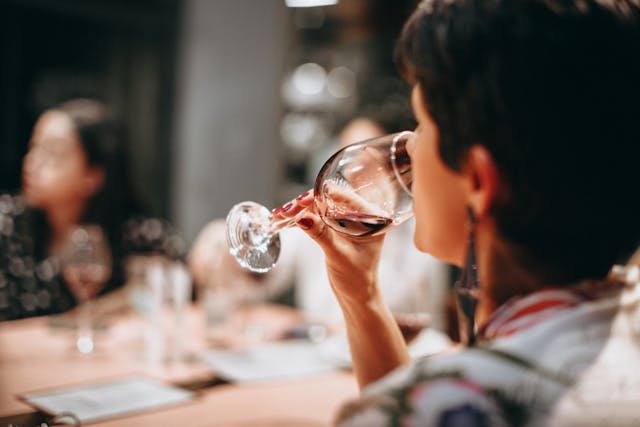The Four Steps of Wine Tasting is a systematic method commonly used when tasting wine. It helps tasters to comprehensively evaluate the quality of wine through a series of steps.
1. Observation of color
Step instructions:
Environmental preparation: Carry out in natural light to avoid strong light or dark light affecting observation.
Observation content: Raise the wine glass in front of a white background and observe the color, color depth and viscosity of the wine.
specific method:
Color: Pay attention to whether the color of the wine is uniform and whether there are any variegated colors.
Color depth: The older the red wine, the lighter the color may be, with a tawny color; the darker color of the white wine may indicate a higher degree of aging or oxidation.
Viscosity: A wine with a high viscosity may have a higher alcohol content or residual sugar content.
Hanging cup phenomenon: observe the flow speed of the wine on the wall of the cup and the formation of “wine tears” or “hanging cup”, which can reflect the alcohol content and surface tension of the wine.
2. Smell the fragrance
Step instructions:
Environmental requirements: Make sure the air environment is clean and odor-free, and avoid smelling fragrance many times in a short period of time, which may lead to a decrease in nasal sensitivity.
specific method:
Place the wine glass 1 to 3 centimeters below your nose, inhale gently, and feel the aroma of the wine evaporate.
After smelling the aroma for the first time, gently shake the wine glass and smell the aroma again, paying attention to the layers and changes of the aroma.
Try to identify fruity, herbal, floral, oaky and earthy aromas in the wine.
3. Taste
Step instructions:
Preparation for tasting: Keep your mouth clean and avoid the influence of spicy food, tobacco and alcohol.
specific method:
Take a small sip of the wine and let the wine fully contact the tip, edges, base of the tongue and roof of your mouth.
Feel the sweetness, acidity, tannin, alcohol and full body of the wine.
Pay attention to discerning the various flavors and aromas in the wine, as well as their persistence and complexity.
4. Summary
Step instructions:
Comprehensive evaluation: Comprehensive information obtained from sight, smell, and taste is combined to make an overall evaluation of the quality of the wine.
Record tasting notes: You can record the color, aroma, taste of the wine, as well as your own feelings and evaluations, which will help with comparison and review in the future.
Optional steps: Compare and taste the wine with other wines, or rate the wine according to a certain scoring system.
Through the above four steps, tasters can systematically evaluate the quality of a wine, thereby better enjoying the pleasure of wine tasting. At the same time, this also requires tasters to have certain professional knowledge and practical experience in order to more accurately distinguish various characteristics and flavors in wine.

